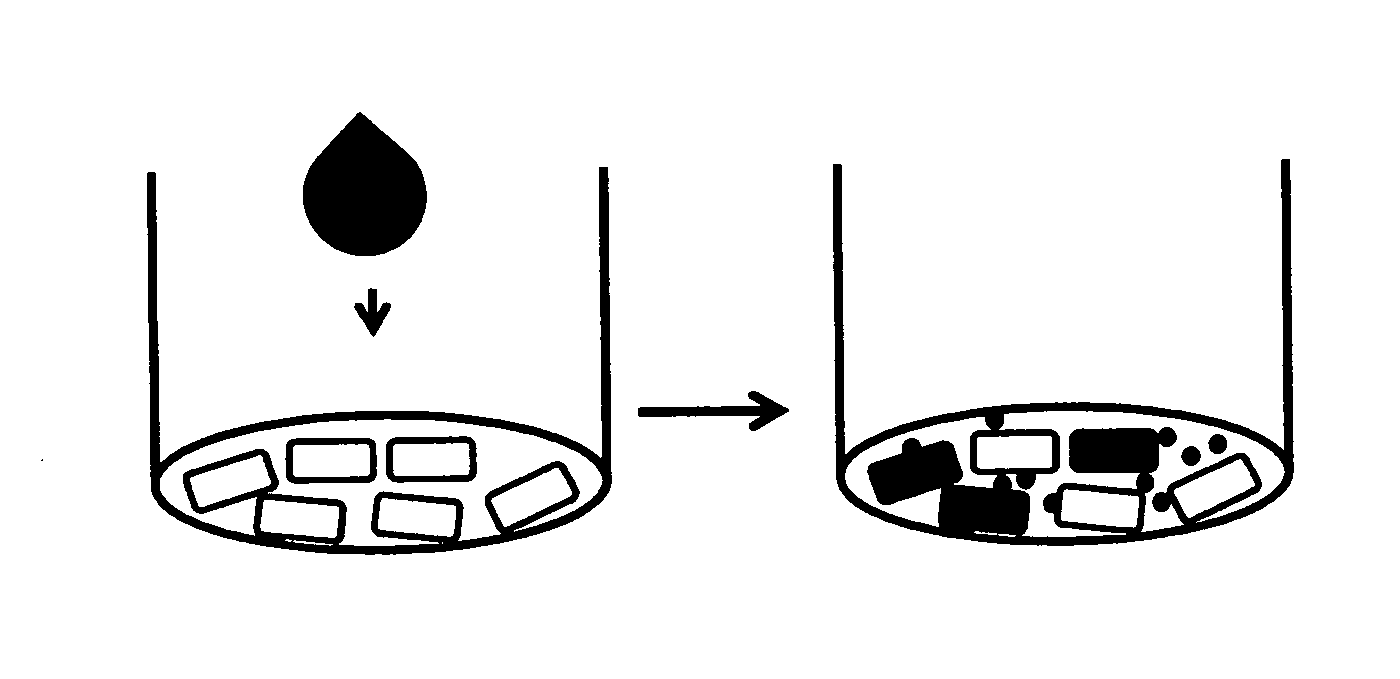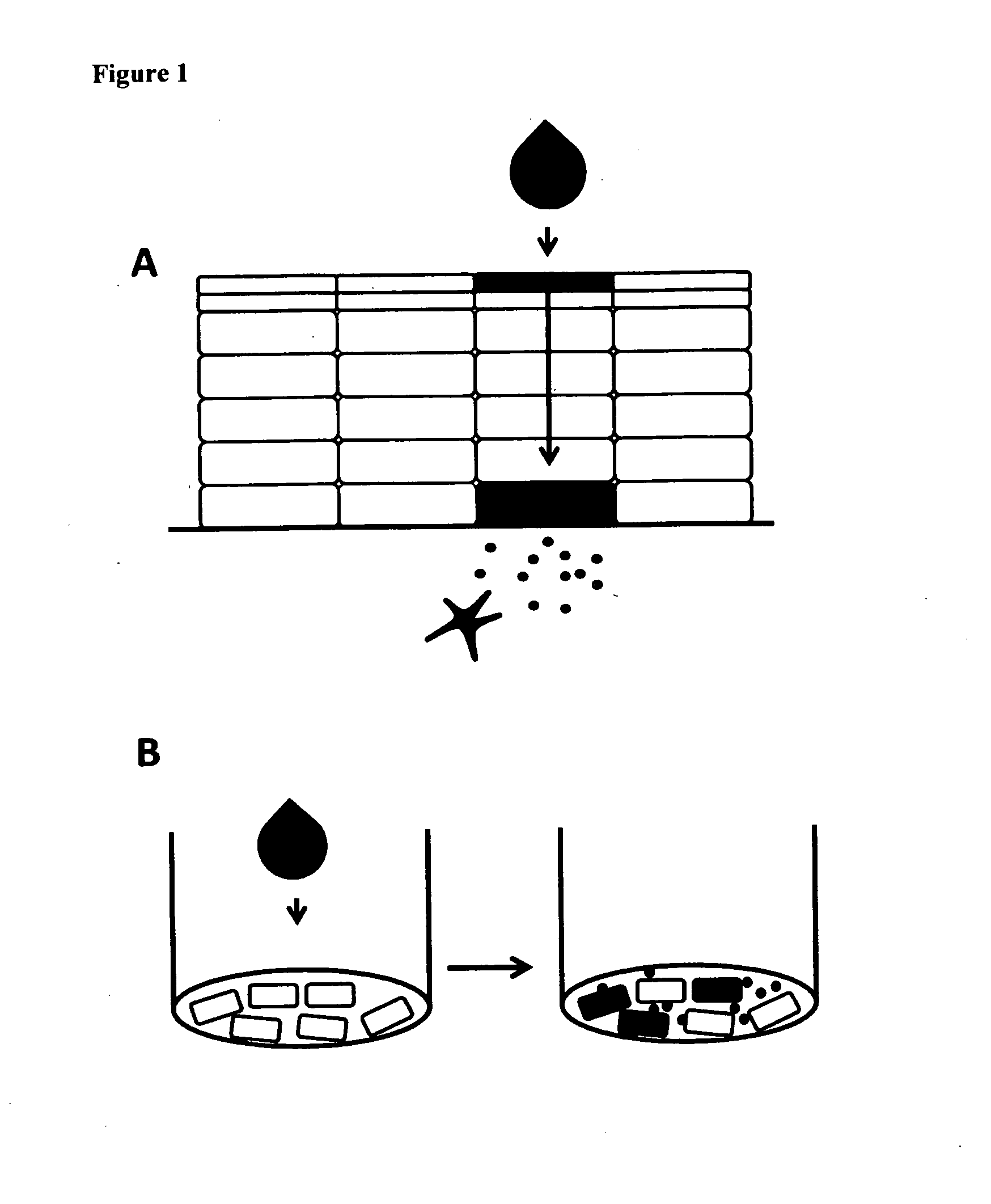Method for screening the sensitizing properties of chemical compounds
- Summary
- Abstract
- Description
- Claims
- Application Information
AI Technical Summary
Benefits of technology
Problems solved by technology
Method used
Image
Examples
example 1
In Vitro Screening of Chemical Compounds for Risk Assessment in ACD. Analysis Using Light Microscopy
Cell Culturing
[0114]Normal human epidermal keratinocytes (HEKn, Cascade Biologics, Portland, Oreg., USA) were maintained in phenol red-free EpiLife keratinocyte medium (Cascade Biologics) supplemented with 60 μM CaCl2, the antibiotics gentamicin / amphotericin and 1% (v / v) human keratinocyte growth supplement (HKGS; Cascade Biologics). Alternatively, Medium 154 containing 200 μM CaCl2 supplemented with HKGS (1% (v / v), without antibiotics is used. Cells were grown at 37° C. in a humidified 5% CO2 incubator. Final concentrations of the components in the supplemented medium were: bovine pituitary extract, 0.2% v / v; bovine insulin, 5 mg / mL; hydrocortisone, 0.18 mg / mL; bovine transferrin, 5 mg / mL; human epidermal growth factor, 0.2 ng / mL; optional: gentamicin, 10 μg / mL and amphotericin B, 0.25 μg / mL. All reagents were obtained from Cascade Biologics, Portland, Oreg., USA. The keratinocytes w...
example 2
In Vitro Screening of Chemical Compounds for Risk Assessment in ACD. Analysis by Fluorescent Dyes
[0145]This example is performed as stated in Example 1, except that 24 h after the addition of test compound (exemplified by oxazolone), 3×90 μl is transferred from each well (concentrations 0.5 mM, 0.05 mM, and 0.005 mM) in the 24-well plate to a 96-well plate (Nunc, F96 multisorp) for the measurement of fluorescence to quantify differences in hapten-induced “blebbing” i.e. the strength of the hapten. 10 μl (final concentration 5 μg / ml) of the dye FM 1-43 (T3163, Molecular Probes, Invitrogen AB, Stockholm, Sweden) is added to each well. The plate is incubated in the dark for 2 minutes and the fluorescence is detected in a plate reader (SpectraMax M2, Molecular Devices, Göteborgs Termometerfabrik, Göteborg, Sweden) with excitation at 510 nm and emission at 626 nm.
[0146]As the dye FM 1-43 is virtually non-fluorescent in aqueous medium but gets intensely fluorescent when inserted in the ce...
example 3
In Vitro Screening of Chemical Compounds for Risk Assessment in ACD. Analysis of Released Proteins
[0147]The quantification of the blebbing response was also made by observing: the amount of released protein (e.g. K5 and K14) through SDS-PAGE and western blots. Blebs were collected and lysed as described in example 4. SDS-PAGE: The samples were diluted (Blebs: 46 μg, 30 μl for blotting and 29.2 μg, 40 μl for SDS-PAGE. K14 and K5: 0.2 μg, 5 μl) with XT Sample Buffer 4X (BioRad, Hercules, Calif., USA) and milli-Q water. 1 μl DTT (2M) was added to each sample followed by heating at 96° C. for 2 minutes before application on the gel. Electrophoresis program: 200V, 400 mA, 50 W, 50 min. MOPS Running Buffer. The gels were fixed, scanned for fluorescence (excitation 480 nm, emission 530 nm) and coomassie stained (Bio-Safe™ Coomassie, BioRad, Hercules, Calif., USA). The gels are then used for quantitative measurement of proteins. Western Blot: Unfixed gels were blotted onto polyvinyldifluori...
PUM
| Property | Measurement | Unit |
|---|---|---|
| Concentration | aaaaa | aaaaa |
| Fluorescence | aaaaa | aaaaa |
Abstract
Description
Claims
Application Information
 Login to View More
Login to View More - R&D
- Intellectual Property
- Life Sciences
- Materials
- Tech Scout
- Unparalleled Data Quality
- Higher Quality Content
- 60% Fewer Hallucinations
Browse by: Latest US Patents, China's latest patents, Technical Efficacy Thesaurus, Application Domain, Technology Topic, Popular Technical Reports.
© 2025 PatSnap. All rights reserved.Legal|Privacy policy|Modern Slavery Act Transparency Statement|Sitemap|About US| Contact US: help@patsnap.com


